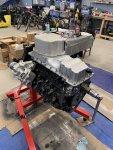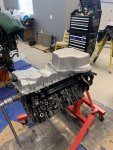Pushing front to back when over wrist pin. Piston to wall clearance was .0028-.0030. I matched the pistons as best I could to the bores as bores came in 4.0755-4.0760. I outlined in post #62 for a bit more on that part of the build. I have a short video you can see the piston moving - trying to post it.im surprised you have that much swing between no rocking and rocking while over the wrist pin. are you rocking top and bottom while the indicator is over the wrist pin or pushing the piston front to back while the indicator is over the wrist pin?
what is your piston to cylinder wall clearance?
LLY - Cracked piston
- Thread starter NevadaLLY
- Start date
You are using an out of date browser. It may not display this or other websites correctly.
You should upgrade or use an alternative browser.
You should upgrade or use an alternative browser.
Pushing front to back when over wrist pin. Piston to wall clearance was .0028-.0030. I matched the pistons as best I could to the bores as bores came in 4.0755-4.0760. I outlined in post #62 for a bit more on that part of the build. I have a short video you can see the piston moving - trying to post it.
- YouTube
Enjoy the videos and music you love, upload original content, and share it all with friends, family, and the world on YouTube.
here’s a video of the piston rocking back to front. This is #1
Pushing front to back when over wrist pin. Piston to wall clearance was .0028-.0030. I matched the pistons as best I could to the bores as bores came in 4.0755-4.0760. I outlined in post #62 for a bit more on that part of the build. I have a short video you can see the piston moving - trying to post it.
aahhh that makes more sense. thats going to give higher numbers when rocking. specially with you measuring near the end of the piston. usually you measure more center between bowl lip and piston edge. you will have to go more off your second set of numbers you posted where you dont rock the piston. in that case, run a C gasket and dont fret. you will have plenty of room and not run into any issues.
it took a bit but im grasping how you are going about this and where the variables are coming from
Now we are getting somewhere with the “how” lol. To me maximum is at the edge. I’ll re-measure at the midline between bore and piston edge.aahhh that makes more sense. thats going to give higher numbers when rocking. specially with you measuring near the end of the piston. usually you measure more center between bowl lip and piston edge. you will have to go more off your second set of numbers you posted where you dont rock the piston. in that case, run a C gasket and dont fret. you will have plenty of room and not run into any issues.
it took a bit but im grasping how you are going about this and where the variables are coming from
Lol. Would be easier if the service manual did and just lined it out clearly. Guess and check blows lol.Yea that sounds like a great idea... Let's just change the measurement location until we get the numbers we like!
Probably why it's not in any service manuals to do so
Why do we Measure Piston Protrusion? - So the piston does not hit the heads.
Given that, you want to measure the piston where and when it sticks out the furthest and base your gasket selection on that number.
Why do we keep the clearance tight? - performance reasons. The tighter the clearance, the better the engine will run.
Gasket selection is a matter of picking the thinnest gasket that will provide the needed clearance. As well as balance the left and right banks as much as possible.
What is the proper clearance?- THAT is the $50 question.
To figure that out, you need to know the squished thickness for each grade gasket. OR you can just look at the GM gasket selection spec and run with it. ( I would, but my electronic manual will not load)
Given that, you want to measure the piston where and when it sticks out the furthest and base your gasket selection on that number.
Why do we keep the clearance tight? - performance reasons. The tighter the clearance, the better the engine will run.
Gasket selection is a matter of picking the thinnest gasket that will provide the needed clearance. As well as balance the left and right banks as much as possible.
What is the proper clearance?- THAT is the $50 question.
To figure that out, you need to know the squished thickness for each grade gasket. OR you can just look at the GM gasket selection spec and run with it. ( I would, but my electronic manual will not load)
James, this is exactly what I was looking for and according to this, I didn't follow the same process to use the tolerances provided by GM. No matter what process you like to use, the tolerances listed in the book are for the process they used. This was my missing piece. I'm going to follow this to the T, check it a couple times, get the average protrusion for each piston, select the max piston protrusion height on that bank (using the average piston calc, not max piston point measured), and see where we land.GM's way of measuring
View attachment 105674
Gasket squish numbers. if you are running headstuds, i base my numbers off the lowest range given by GM
View attachment 105675
I'll re-run the measurements on Sat. I'm building a house at the same time building a truck - I wouldn't recommend it! LOL.
I somewhat disagree with rocking the piston. While that is the farthest it could stick out, it won't do that in use due to cylinder pressure. Static compression is 300+ PSI on a Duramax, and that will keep the piston from getting completely cockeyed and one edge hitting the head, IMO. There will be hundreds of pounds of force equally on all parts of a piston pushing it away from the head, so it should stay straight in the bore while running. That is why I only measure over the wrist pin, with the piston centered in the bore.
When I did my engine, I didn't rock the piston, just ran it back and forth over TDC a few times and used the biggest number from the side that came out the most. I then used the biggest piston on each bank to select the gasket, since that is the worst-case number.
I believe your earlier measurements put you with a Grade A on both banks, though it is close to a Grade B on the even bank. Let us know what you come up with on your (hopefully final) re-measure Saturday
When I did my engine, I didn't rock the piston, just ran it back and forth over TDC a few times and used the biggest number from the side that came out the most. I then used the biggest piston on each bank to select the gasket, since that is the worst-case number.
I believe your earlier measurements put you with a Grade A on both banks, though it is close to a Grade B on the even bank. Let us know what you come up with on your (hopefully final) re-measure Saturday
I somewhat disagree with rocking the piston. While that is the farthest it could stick out, it won't do that in use due to cylinder pressure. Static compression is 300+ PSI on a Duramax, and that will keep the piston from getting completely cockeyed and one edge hitting the head, IMO. There will be hundreds of pounds of force equally on all parts of a piston pushing it away from the head, so it should stay straight in the bore while running. That is why I only measure over the wrist pin, with the piston centered in the bore.
When I did my engine, I didn't rock the piston, just ran it back and forth over TDC a few times and used the biggest number from the side that came out the most. I then used the biggest piston on each bank to select the gasket, since that is the worst-case number.
I believe your earlier measurements put you with a Grade A on both banks, though it is close to a Grade B on the even bank. Let us know what you come up with on your (hopefully final) re-measure Saturday
I can tell you for a fact that they do rock while running. Especially when cold.
Keep in mind that the GM (and other manufacturer's ) specs take into account piston rock within the PTW service specs.
Exactly, so unless PTW changed dramatically (e.g. forged pistons) then measuring the GM way (without rocking) will lookup to the correct gasket.I can tell you for a fact that they do rock while running. Especially when cold.
Keep in mind that the GM (and other manufacturer's ) specs take into account piston rock within the PTW service specs.
I could be wrong about the cylinder pressure forcing it straight, on further thought. That is the whole deal with a butterfly valve/throttle: the equal pressures cancel out so it isn't hard to turn them out of alignment with the bore. Hmm, but butterfly valves apply the force co-axially while piston faces are offset from the wrist pin. Definitely not as simple as I thought initially.
New measurements done. Followed instructions above exactly.
piston protrusion: front, back, average
Bank1
1: .0075, .0075, .0075
3: .0080, .0080, .0080
5: .0065, .0085, .0075
7: .0050; .0070, .0060
Bank2
2: .0095, .0095, .0095
4: .0100, .0090, .0095
6: .0095, .0085, .00875
8: .0080, .0065, .00725
Bank1: high = .0080, gasket A
Bank2: high = .0095, gasket A
Using head studs, if we assume squish to minimum gasket thickness, grade C will see .0394, or top of A gasket tolerance but 4 thou high. Since I’m on the low side of protrusion, I’d guess we need to see A.
New question...C will accept overbore. Will A or B?
piston protrusion: front, back, average
Bank1
1: .0075, .0075, .0075
3: .0080, .0080, .0080
5: .0065, .0085, .0075
7: .0050; .0070, .0060
Bank2
2: .0095, .0095, .0095
4: .0100, .0090, .0095
6: .0095, .0085, .00875
8: .0080, .0065, .00725
Bank1: high = .0080, gasket A
Bank2: high = .0095, gasket A
Using head studs, if we assume squish to minimum gasket thickness, grade C will see .0394, or top of A gasket tolerance but 4 thou high. Since I’m on the low side of protrusion, I’d guess we need to see A.
New question...C will accept overbore. Will A or B?





